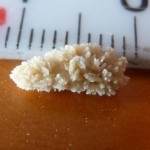 Chances are you or someone you know has had a kidney stone at some point in their life; they are very common, affecting approximately one in ten people throughout their lifetime. The risk of kidney stones is higher in the United States than the rest of the world and this number has only been increasing over the past two to three decades.
Chances are you or someone you know has had a kidney stone at some point in their life; they are very common, affecting approximately one in ten people throughout their lifetime. The risk of kidney stones is higher in the United States than the rest of the world and this number has only been increasing over the past two to three decades.
Kidney stones are small, hard deposits, typically composed of mineral and acid salts that form inside your kidneys. As one might expect, because urine is a vehicle for waste excretion, it is comprised of numerous chemicals and wastes. When the urine is too concentrated, that is too little liquid and too much waste, crystals will begin to form. Over time, these crystals can join together and form a larger stone-like solid.
There is no single cause for kidney stones and often, the cause is unknown. There are, however, different types of kidney stones, which can help pinpoint the origin. Calcium stones, for example, are the most common form of kidney stone. Oxalate is a naturally occurring substance in food, so anything that increases levels of this compound, can increase the risk of a kidney stone. Uric acid stones often form in people who do not consume enough fluids, eat high protein diets or have gout. Struvite stones often form as the result of a kidney infection.
Some characteristic symptoms of kidney stones are:
• Severe flank pain
• Intense, fluctuating and throbbing pain
• Pain on urination
• Blood in urine
• Nausea and vomiting
• Urgency to urinate
Treatment for kidney stones primarily depends on the size of the stone. If it is smaller than four millimeters in diameter, you have a good chance of passing it naturally. Increasing water consumption and certain medications can assist in passing these smaller stones. Stones of 5 mm diameter have an average of 50% change to passing. The probability of passing naturally decreases as the stone’s diameter increases. Larger stones may require surgical intervention such as shock-wave treatment, where high-energy sound waves break up the stone, or manual stone extraction. The best test for diagnosing stones and finding out their magnitude, is a non-contrast CT scan.
Treatment for kidney stones primarily depends on the size of the stone. If it is smaller than four millimeters in diameter, you have a good chance of passing it spontaneously. Consuming two to three quarts of water a day and using a pain reliever can help pass these small stones. Larger stones may require invasive treatment including: surgery, using a scope passed through the urethra or shock-wave lithotripsy, where high-energy sound waves break up the stone in to more easily passable stones.
Prevention of kidney stones can be as simple as a few dietary changes. Consuming more water during the day is one of the easiest measures you can take. Doctors recommend excreting about 2.6 quarts of urine every day. Depending on the severity of your kidney stones, you may want to measure and monitor your urine excretion. Consume fewer oxalate-rich foods, especially if you tend to form calcium oxalate stones. Such foods include chocolate, soy products, okra, beets, sweet potatoes, tea and nuts.
Consume foods low in salt and animal protein. Speak with your doctor about your calcium intake via food and supplements before making any changes here.



